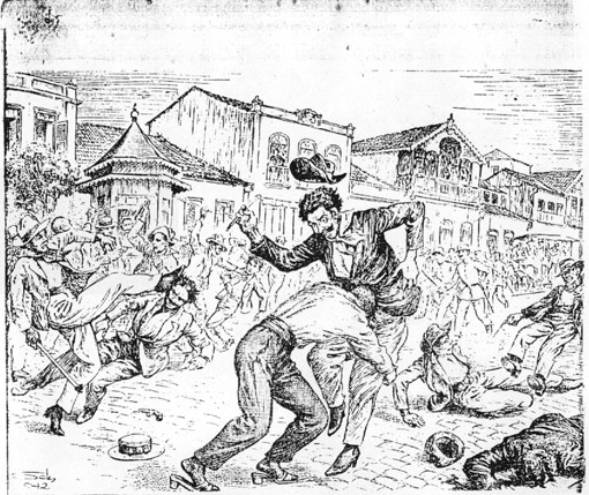
https://www.youtube.com/watch?v=F71x5H04Nsw
(There is a mistake in the video; the mechanics should be Leopard+LightLegs; not Snake+LightLegs)
Calço is a low takedown; outwardly somewhat similar to Corta capim; but working on a completely different principle.

(An old engraving; on the right, Calço against both legs; on the left, Calço against a kick)
Calço uses Leopard+LightLegs mechanics; with Seduction1 for the final part.
-
The opponent has his left leg in the front. Equip LightLegs and enter diagonally from the right.
Drop down on your left arm; as you sweep forward with your right leg; hitting the top part of opponent's left calf; from the side; with your right knee. This is a high-energy point("Haaaa!").
Done right and to the proper spot, this applies a nerve strangle; making the opponent dizzy and weak, unbalanced to his rear.
Continue with the sweep; drop back on both arms, taking both opponent's legs from the back, loading your left foot and then springing off it, lifting opponent's both legs into the air so he falls to the rear on his back. (Seduction1)
Note that you drop on your left hip after the lift. This is a part of the technique.
-
- The key to the technique is the nerve strangle; it makes the opponent lose his ballance to the rear so you can sweep/lift both his legs. You must hit the right spot with your right knee and use the proper vocalization.
- You do not sweep opponent's legs with a swing of your leg; that would not work or require too much force. Instead, you apply the nerve strangle, and then, while he is off ballance to the rear, lift his legs up.
- This is not a power technique! If you use the nerve strangle, it is easy to lift opponent's legs.
- Calço is related to Corta capim, as they are tactically similar; however, the principle of the takedown is different: Pulling in Corta capim and nerve strangle in Calço
- Hermanny(1955) calls the technique 'Corta capim'; and apparently does it wrong, without the nerve strangle; thus just relying on brute strength. This is not Calço (and even less Corta capim).
(Hermanny doing the final movement of Calço; calling it Corta capim and doing it wrong; the mechanic archetype tells the story).
- As seen on the engraving above, Calço can also be used against a kick as a sort of 'power low rasteira'. The principle however remains the same; first, apply the nerve strangle to the standing leg, then lift the leg.
- Drop down on your arms in the normal Calço.
- Burlamaqui(1928) also seems not to understand the principle of Calço(he calls it facao). He describes it as 'sweeping opponent's leg when it is in the air'; which is stupid (how do you sweep somebody who is in the air?).
Instead, what he probably means is what happens when you do a true Calço against opponent's kick: As he kicks, and you apply a nerve strangle to his standing leg, it makes him dizzy, which results in his kicking leg dragging his standing leg into the air with it; then you, indeed, sweep the opponent as he is airborne. The resulting fall is hard, just as Burlamaqui writes.
- Do not confuse Calço with Low rasteira or Corta capim; as their principles are distinct.
Later notes (5.5.2024):
Calço is not 'Corta capim' because it does not 'cut grass'; ie unlike Corta capim, the leg does not swing in a circle along the ground as a sickle would.
Instead, Calço is a 'chock'; it feels like a wedge driven under opponent's legs, tilting him backward.
The names capture the different principles of the two takedowns beautifully: Corta capim sweeps and pulls; Calço drives underneath and lifts.
-
Tactically, Calço is poor man's Corta capim; when Capoeiragem Carioca became so degenerated the fighters were not able to apply Corta capim anymore, they used Calço.
And if Hermanny executed the technique as he shows on the photo, then in 1955, Calço degenerated even more, becoming physical technique reliant on power.
-
In some sources, Banda de lado is called calço(because it is also sort-of wedge-like); and Burlamaqui calls Tombo de ladeira calço.
This Web Page was Built with PageBreeze Free HTML Editor